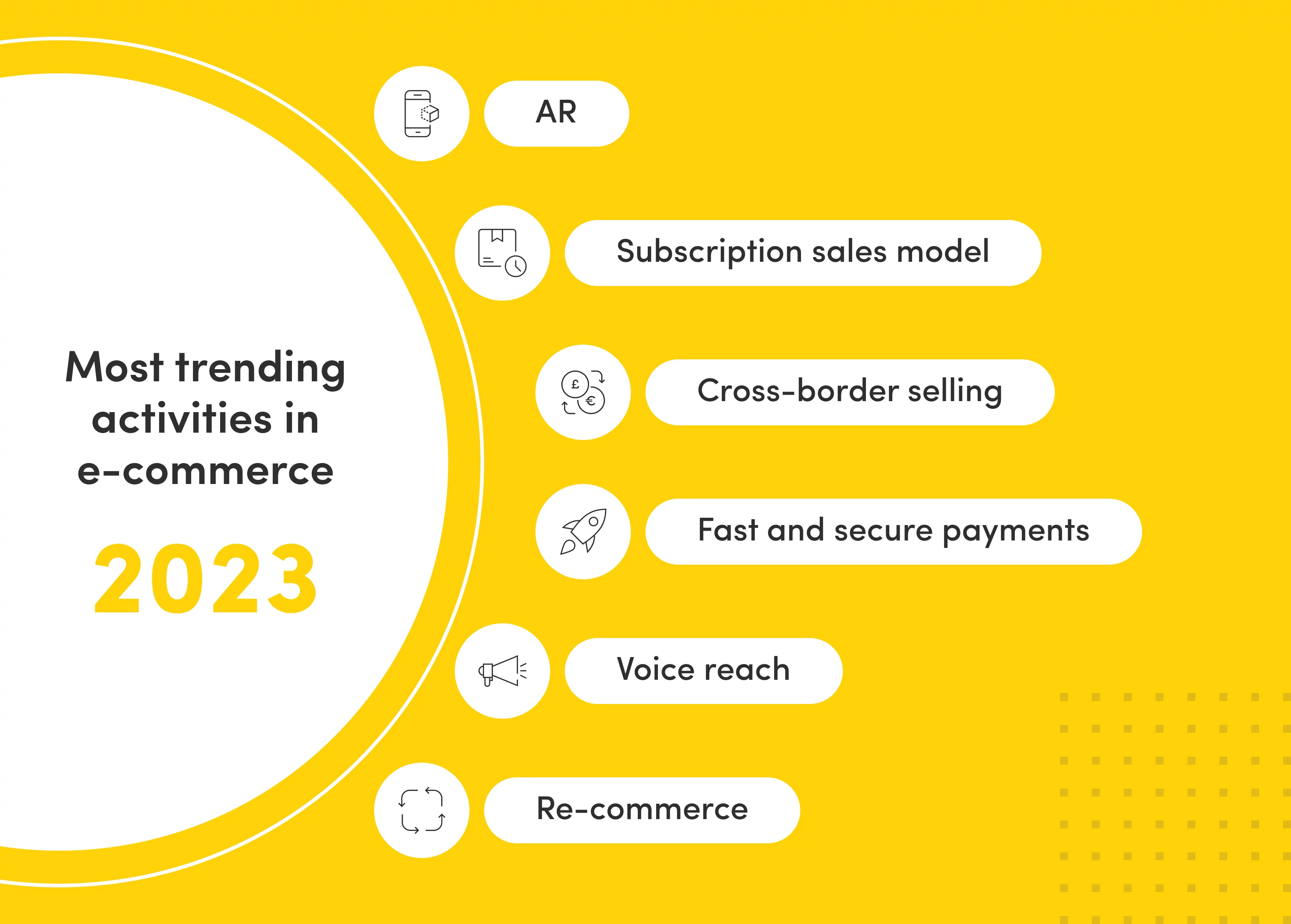The e-commerce industry is one of the most resilient sectors. Especially in the post-pandemic period, stabilization and further growth predictions can be seen. Read on to find out what current and upcoming trends are worth keeping an eye on – and make sure your brand is one step ahead of the competition!
As reported by Shopify Plus after the Statista report: while the market returned to its record growth rate in 2022, despite the economic situation, e-commerce growth in 2023 is expected to be 5% higher than before the pandemic and to stabilize in the following years. Not surprisingly, this industry is accompanied by constant change, and we can see new trends and their forecasts basically from quarter to quarter.
In this article, we will focus on some of what we believe are the most trending e-commerce activities in 2023. We will look at them through the eyes of our clients, who are the experts in their industries, and know which trends are the most interesting and promising for them.

Augmented Reality in the e-commerce sector of the furniture industry
One of the trendiest technologies in recent years is Augmented Reality [AR]. It enables the real world to be combined with digitally produced images. In contrast to VR [virtual reality], AR makes use of the surrounding environment, thereby not producing a fully artificial image.
With AR, an image (e.g. from a phone camera) is processed and placed in the form of a 3D model in a scanned space. Thus, we will see this space enriched with a given 3D model, which will make it easier to assess whether, for example, a piece of furniture fits into our living room. This type of product presentation has been used in the home and decor brands we work with, including Oakywood and Optisofa.
How is AR seen from the perspective of the shop founder?
Oakywood

“While working on our new website, one of our goals was to improve product presentation. The main challenge was to accurately present the unique properties of the natural materials our products are made of, as well as their shapes and textures. AR technology proved to be the ideal solution, as it allows customers to view the products in their actual size and preview them from all sides, providing a unique product experience.
To add AR models to our shop, a 3D scan of our products was required. We sent them to our technology partner, Precismo of the Czech Republic, who used advanced texture transfer technology to transfer the products into a virtual environment. Digital models were then created and integrated into our website, allowing customers to virtually test the products in their workspaces.
In my opinion, AR technology will find application in many industries. In e-commerce, its use is obvious and will soon become one of the elements expected by customers when browsing a brand’s product offering. AR provides customers with more accurate product information and specifications that allow them to almost physically test the product in their own space. This contributes to a better understanding of the product and potentially increases the chances of buying it. AR can also contribute to a reduction in the number of returns, thus reducing the costs associated with shipping and handling returns.”

E-commerce subscription model
Reports leave no doubt – this e-commerce sales model is gaining strength. Especially after the pandemic times, when we left our homes less often. Three main types of subscription sales can be distinguished – restocking, regular shipments of new products, so-called curation boxes, and memberships.
One of the most interesting subscription-related solutions is an app for Bosch dishwashers, which connects to the Shopify shop allowing you to order the right Finish capsules when the product ran out. Will such solutions soon be more common in our homes?
Let’s find out what our customers are saying about this model of sales:
Modern Wine Club

“Wanting to prepare logistically for subscription sales, it is worth taking care of mechanisms to anticipate the amount of stock required for upcoming orders. Just as important is the way they are booked and the variety of SKUs. It is also worth continually emphasizing communication on how the subscription itself works. This sales model is gaining in popularity, but consumers are still sometimes uncertain and apprehensive about joining such purchasing programs. It is also worth building sales models as flexibly as possible, with a pro-customer approach. Meanwhile, in the shop itself, it is worth communicating the advantages of such a shopping method transparently.
Before adopting such a model, it is worth considering to what extent our product is one that consumers buy regularly at specific intervals. Depending on the product and industry, it is also worth thinking about the frequency of the subscription. It doesn’t always have to be renewed every month or two. The most important thing in building a subscription is the LTV (lifetime value) of the customer, i.e. how long they will stay with us. If our product sells better over a longer interval, that’s fine too.”

Cross-border selling in e-commerce for the fashion industry
Cross-border, or international selling, is a growing practice among thriving fashion e-commerce businesses. Due to the strong development of the e-commerce sector itself and its technology, such sales are becoming easier and more accessible, even for brands that have so far been limited to selling within one country or continent. Sometimes the reason for going cross-border is to develop the brand itself, but it also happens that local markets are not the target audience for a product. In such cases, broader international sales are advisable.
What experiences have our customers had with cross-border sales?
God Save Queens

“Cross-border selling has been a key part of our business strategy for several years now. We recognized early on that there was a strong demand for our products from customers around the world, and we wanted to make sure that we could meet that demand. We started by testing the waters in a few key markets, and as we saw success, we continued to expand our reach.
Our experiences with cross-border selling have been very positive overall. Of course, there have been some challenges along the way, such as navigating different regulations and customs requirements in different countries, as well as dealing with language and cultural barriers. However, we have found that these challenges are far outweighed by the benefits of being able to reach a global audience and build our brand on a global scale.
In terms of who cross-border selling is for, I would say that it can be a great option for any business that has products that are in demand in other countries. It is particularly beneficial for businesses that sell unique or high-quality products that are not readily available in other markets. However, cross-border selling may not be suitable for all businesses. For example, companies with very low margins or businesses that sell products that are heavily regulated or restricted in other countries may find it more challenging.
Given the increasingly global nature of e-commerce, we believe that cross-border selling will only become more popular in the coming years. As more and more consumers around the world become comfortable with online shopping, businesses that are able to successfully navigate the complexities of cross-border selling will be well positioned for growth and success.”

Faster and secure online payment methods
The topic of online payments in e-commerce is particularly exciting for business owners and merchants of e-commerce technologies such as Shopify. It has been known for a long time that users pay attention not only to the way but also to the security of payments on a shopping site. They choose their favorite methods and expect a smooth transaction process and this affects the final conversion.
What opportunities in e-commerce payments do users have today?
imoje

“The on-line payment sector is constantly evolving – such are the expectations of the market and new technological trends. And in my opinion, the following initiatives are particularly worth noting:
BLIK B2B
BLIK is currently the most popular payment method in Polish e-commerce among payers who are natural persons. This is confirmed by the number of transactions and the increasing number of users of the service, e.g. based on data from the National Bank of Poland for the first half of 2022, we have observed a 215% higher number of BLIK transactions than by payment cards.
Often, solutions developed for a specific sector as a result of a major success are then adapted and made available to the next group of interested parties. Last year, ING Bank Śląski was the first bank in Poland to make BLIK payments available to the corporate sector. We were met with an overwhelming response once the service became available. It is a natural alternative to traditional corporate cards. We had over 1,500 activations already in the first week, and there are now over 26,000. I expect that other banks will also make the service available to their clients and the functionality will be positively received by all those interested.
PBL 2.0
Fast electronic transfers (pay-by-link) were created to facilitate transactions for internet users who are natural persons. Thanks to the new standard of payment services and the development of on-line payment systems, last year it was possible to make fast on-line transfer options available to the market for B2B payers. The solution was very well received due to the significant simplification of the payment process. It involved making standard transfers based on an invoice received or paying with a company card via a payment link received using an on-line payment gateway (e.g. imoje). The payment process itself is no different from finalising a transaction through a “normal” PBL, the only difference being that you can log into your company account. Importantly, not all banks allow their corporate clients to pay using “PBL 2.0”, but I believe the number will grow.
The clients we work with tell us that the payers confirm the fact that payments are significantly easier and, above all, about the associated time savings and the elimination of possible errors.
Buy Now Pay Later – deferred payments:
B2C
It is a payment method that allows you to buy goods or services without using your own money at the time of purchase. This is particularly helpful when shopping for products in the fashion category. The client can try the clothes on and then – if necessary – return them, without having to pay for the order and then wait for a transfer from the e-shop.
There are five providers of the BNPL solution for individual clients on the Polish market – PayPo, Twisto, Klarna, Mokka and Allegro, while BLIK, Alior Bank and PKO BP are also introducing their deferred payments.
As a curiosity I would like to add that CCC, in cooperation with PayPo, was the first in Poland to introduce the possibility of paying for an order in a stationary shop using a BNPL payment initiated by its own application.
B2B
Most on-line shops offer the possibility for corporate clients to finalise their purchases. It is therefore worth noting whether we have made dedicated payments available in our e-shop, e.g. deferred payments for B2B. This form of financing is much simpler from the payer’s perspective than going through the standard bank loan route. Payments are deferred for a period of between 14 and 60 days on clearly defined conditions up to the amount of PLN 100,000 – PragmaGO S.A. is the leader in the Polish e-commerce market. The said payment method is available on the imoje payment gateway, which is the first implementation of BNPL payments for companies, among the payment operators active in the market.”

Voice search in e-commerce
Voice technologies are rapidly gaining popularity, so it is no surprise that they are included in this list. Voice Search is a speech recognition technology that enables quick search phrases without using the keyboard of a mobile device.
The best-known example of this is Google’s voice search. Among voice technologies, we can also distinguish Voice-Enabled Shopping/Voice Commerce, which are technologies that allow us to make purchases using only our voice and a mobile device or assistant (e.g. Amazon Alexa, Google Nest).
How else can we use Voice Search in e-commerce?
edrone

“Voice Search enables us to improve conversion results on mobile. Firstly, the consumer does not have to type in product-related keywords, he just has to tell the search engine what he is looking for naturally for him, and in a split second, he can browse the suggestions. An example? “I’m looking for women’s shoes for a wedding, in beige, size 38, and the price should not exceed £250.” In addition to user comfort, searching for products by voice makes e-commerce accessible to all users, regardless of limitations, age, or digital prowess.
At edrone, we started working on voice search technology more than two years ago. Our team has developed a tool that is already being implemented on a test basis in online shops. The Mobile Voice Search Widget is the first solution of its kind on the Polish market, dedicated specifically to e-commerce, which uses advanced machine learning (ML) algorithms to take search quality to a whole new level. It understands product features (categories, parameters) at a much higher level of detail than Google or Siri, which is why it works well in e-commerce. To build the search engine, we used:
- ASR, or Automatic Speech Recognition,
- NLU: Natural Language Understanding,
- conversation module and an interactive search engine, which allows you to change search parameters without having to start the process from scratch.
Voice Search is a rapidly growing trend in the West and it is only a matter of time before it becomes an integral part of Polish e-commerce. Just look at the statistics. 72% of people using voice search devices say that it has become part of their daily routine. Let’s pay attention to how popular voice messages are among well-known communicators. So it will be natural for them to look for a similar experience on websites and online shops. As with any novelty, Voice Search is something we need to get used to – both consumers and e-commerce owners – but the voice revolution will happen faster than you might think.”

The increasing significance of recommerce
Selling second-hand products is a concept we have been familiar with for years. But can it be applied to e-commerce shops? It turns out that yes! The sale of second-hand products, or so-called recommerce, is becoming increasingly popular in the fashion industry. Zalando (Zalando Pre-owned) introduced buying back from its customers some time ago, and the Osnova brand also runs its Circular Wardrobe. But do such practices apply to other industries?
Zieta Studio

“The growing awareness of consumers pleases and at the same time poses challenges – also for the design industry. At Zieta Studio, we operate in an interdisciplinary and holistic way – we design objects and their production processes. Since the company’s inception, we have focused on the reduction – of time, energy, virtual data, or the weight of objects.
For years, we have been guided by the principles of a circular economy. Our facilities are predominantly mono-material. Manufactured mainly from metal – steel, aluminum, or copper, they are almost 100% renewable. To emphasize the qualities of the organization’s products and values, along with the redevelopment of the website, we decided to implement recommerce, in the Circular Objects edition. We want to encourage audiences to reach for objects that start their life cycle at the ‘Reuse’ level. That is post-show, second-grade objects and those refabricated – refreshed, recycled, and re-marketed. We also plan to add a series of individual objects that are intermediate products created during the production of the collection. We will give them a functional or aesthetic function while provoking clients to discuss the definition of a given form and its potential. We want to experiment together.
E-commerce solutions provide global access to local ideas. The growing number of R’s in the wheel of the circular economy makes us hopeful for a future, one in which both producers and consumers are highly responsible for their choices. Industries such as interior design, art, and design, therefore, have a wide range of opportunities.”

Conclusion
E-commerce trends are a process that we have been observing in the industry for years. It is worth paying attention to them, especially when planning long-term activities. This will not only make it easier to reach more customers by facilitating the purchasing process but will also ensure the growth of the business itself. Innovative online payment methods, augmented reality, e-commerce, or recommerce – I am sure we will hear about these trends in the industry more than once.
sources:
https://omnichannelnews.pl/2023/01/02/e-handel-w-2023-r-cross-border-ai-omnichannel-chatboty/
https://harbingers.io/blog/co-to-jest-recommerce-przyklady
https://bluemedia.pl/baza-wiedzy/blog/ecommerce/rozwoj-recommerce-w-polsce






